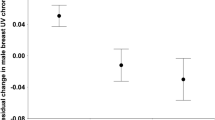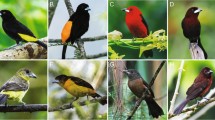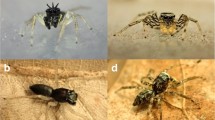Abstract
In many animals, conspicuous coloration functions as a quality signal. Indicator models predict that such colors should be variable and condition dependent. In Habronattus pyrrithrix jumping spiders, females are inconspicuously colored, while males display brilliant red faces, green legs, and white pedipalps during courtship. We tested the predictions of the indicator model in a field study and found that male body condition was positively correlated with the size, hue, and red chroma of a male’s facial patch and negatively correlated with the brightness of his green legs. These traits were more condition dependent than non-display colors. We then tested a dietary mechanism for condition dependence using two experiments. To understand how juvenile diet affects the development of coloration, we reared juvenile spiders on high- and low-quality diets and measured coloration at maturity. To understand how adult diet affects the maintenance of coloration, we fed wild-caught adults with high- or low-quality diets and compared their coloration after 45 days. In the first experiment, males fed high-quality diet had redder faces, suggesting that condition dependence is mediated by juvenile diet. In the second experiment, red coloration did not differ between treatments, suggesting that adult diet is not important for maintaining the color after it is produced at maturity. Diet had no effect on green coloration in either experiment. Our results show different degrees of condition dependence for male display colors. Because red is dependent on juvenile diet, it may signal health or foraging ability. We discuss evidence that green coloration is age dependent and alternatives to indicator models for colorful displays in jumping spiders.




Similar content being viewed by others
References
Andersson M (1982) Sexual selection, natural selection and quality advertisement. Biol J Linn Soc 17:375–393
Andersson M (1994) Sexual selection. Princeton University Press, Princeton
Basolo AL (1990) Pre-existing mating biases and the evolution of the sword in the genus Xiphophorus. Am Zool 30:A80–A80
Boughman JW (2007) Condition-dependent expression of red colour differs between stickleback species. J Evol Biol 20:1577–1590
Clark DL, Uetz GW (1993) Signal efficacy and the evolution of male dimorphism in the jumping spider, Maevia inclemens. Proc Natl Acad Sci USA 90:11954–11957
Cohen AA, McGraw KJ, Wiersma P, Williams JB, Robinson WD, Robinson TR, Brawn JD, Rickletfs RE (2008) Interspecific associations between circulating antioxidant levels and life-history variation in birds. Am Nat 172:178–193
Contreras-Garduno J, Buzatto BA, Serrano-Meneses MA, Najera-Cordero K, Cordoba-Aguilar A (2008) The size of the red wing spot of the American rubyspot as a heightened condition-dependent ornament. Behav Ecol 19:724–732
Cotton S, Fowler K, Pomiankowski A (2004) Do sexual ornaments demonstrate heightened condition-dependent expression as predicted by the handicap hypothesis? Proc Biol Sci 271:771–783
Couldridge VCK, Alexander GJ (2002) Color patterns and species recognition in four closely related species of Lake Malawi cichlid. Behav Ecol 13:59–64
Crane J (1949) Comparative biology of salticid spiders at Rancho Grande Venezuela. Part IV: an analysis of display. Zoologica 34:159–214
Dale J (2006) Intraspecific variation in coloration. In: Hill GE, McGraw KJ (eds) Bird coloration: function and evolution. Harvard University Press, Cambridge
Delhey K, Peters A (2008) Quantifying variability of avian colours: are signalling traits more variable? PLoS ONE 3:e1689
Devoe R (1975) Ultraviolet and green receptors in principal eyes of jumping spiders. J Gen Physiol 66:193–207
Elias DO, Mason AC, Maddison WP, Hoy RR (2003) Seismic signals in a courting male jumping spider (Araneae: Salticidae). J Exp Biol 206:4029–4039
Foelix RN (1996) Biology of spiders. Oxford University Press, New York
Forster L (1982) Visual communication in jumping spiders. In: Witt PN, Rovner JS (eds) Spider communication: mechanisms and ecological significance. Princeton University Press, Princeton
Giraldo MA, Stavenga DG (2008) Wing coloration and pigment gradients in scales of pierid butterflies. Arthropod Struct Dev 37:118–128
Griswold CE (1987) A revision of the jumping spider genus Habronattus F.O.P. Cambridge (Araneae: Salticidae), with phenetic and cladistic analyses. Univ Calif Publ Entomol 107:1–344
Guilford T, Dawkins MS (1991) Receiver psychology and the evolution of animal signals. Anim Behav 42:1–14
Hebets EA, Papaj DR (2005) Complex signal function: developing a framework of testable hypotheses. Behav Ecol Sociobiol 57:197–214
Hebets EA, Wesson J, Shamble P (2008) Diet influences mate choice selectivity in adult female wolf spiders. Anim Behav 76:355–363
Hill DE (1979) Scales of salticid spiders. Zool J Linn Soc 65:193–218
Hill GE (1990) Female house finches prefer colorful males—sexual selection for a condition-dependent trait. Anim Behav 40:563–572
Hill GE (2006) Environmental control of ornamental coloration. In: Hill GE, McGraw KJ (eds) Bird coloration: function and evolution. Harvard University Press, Cambridge
Jackson RR (1981) Relationship between reproductive security and intersexual selection in a jumping spider Phidippus johnsoni (Araneae, Salticidae). Evolution 35:601–604
Jakob EM, Marshall SD, Uetz GW (1996) Estimating fitness: a comparison of body condition indices. Oikos 77:61–67
Kemp DJ (2006) Heightened phenotypic variation and age-based fading of ultraviolet butterfly wing coloration. Evol Ecol Res 8:515–527
Kemp DJ, Macedonia JM (2006) Structural ultraviolet ornamentation in the butterfly Hypolimnus bolina L. (Nymphalidae): visual, morphological and ecological properties. Aust J Zool 54:235–244
Kemp DJ, Rutowski RL (2007) Condition dependence, quantitative genetics, and the potential signal content of iridescent ultraviolet butterfly coloration. Evolution 61:168–183
Kodric-Brown A (1989) Dietary carotenoids and male mating success in the guppy—an environmental component to female choice. Behav Ecol Sociobiol 25:393–401
Kokko H, Lindstrom J (1996) Evolution of female preference for old mates. Proc R Soc B 263:1533–1538
Lebas NR, Marshall NJ (2001) No evidence of female choice for a condition-dependent trait in the agamid lizard, Ctenophorus ornatus. Behaviour 138:965–980
Lenouvel P, Gomez D, Thery M, Kreutzer M (2009) Do grooming behaviours affect visual properties of feathers in male domestic canaries, Serinus canaria? Anim Behav 77:1253–1260
Li JJ, Zhang ZT, Liu FX, Liu QQ, Gan WJ, Chen J, Lim MLM, Li DQ (2008) UVB-based mate-choice cues used by females of the jumping spider Phintella vittata. Curr Biol 18:699–703
Lim MLM, Li DQ (2004) Courtship and male–male agonistic behaviour of Cosmophasis umbratica Simon, an ornate jumping spider (Araneae: Salticidae) from Singapore. Raffles Bull Zool 52:435–448
Lim MLM, Li DQ (2006) Behavioural evidence of UV sensitivity in jumping spiders (Araneae: Salticidae). J Comp Physiol A 192:871–878
Lim MLM, Li DQ (2007) Effects of age and feeding history on structure-based UV ornaments of a jumping spider (Araneae: Salticidae). Proc R Soc B 274:569–575
Lim MLM, Land MF, Li DQ (2007) Sex-specific UV and fluorescence signals in jumping spiders. Science 315:481–481
Lim MLM, Li JJ, Li D (2008) Effect of UV-reflecting markings on female mate-choice decisions in Cosmophasis umbratica, a jumping spider from Singapore. Behav Ecol 19:61–66
Maddison WP (1995) Salticidae section of the tree of life web project. http://tolweb.org/salticidae. Accessed 25 April 2010
Maddison WP, Stratton GE (1988) Sound production and associated morphology in male jumping spiders of the Habronattus agilis species group (Araneae, Salticidae). J Arachnol 16:199–211
Masta SE, Maddison WP (2002) Sexual selection driving diversification in jumping spiders. Proc Natl Acad Sci USA 99:4442–4447
Mayntz D, Toft S (2001) Nutrient composition of the prey's diet affects growth and survivorship of a generalist predator. Oecologia 127:207–213
Mayntz D, Raubenheimer D, Salomon M, Toft S, Simpson SJ (2005) Nutrient-specific foraging in invertebrate predators. Science 307:111–113
McGraw KJ (2006a) Mechanics of carotenoid-based coloration. In: Hill GE, McGraw KJ (eds) Bird coloration: mechanisms and measurements. Harvard University Press, Cambridge
McGraw KJ (2006b) Mechanics of melanin-based coloration. In: Hill GE, McGraw KJ (eds) Bird coloration: mechanisms and measurements. Harvard University Press, Cambridge
Møller AP, Pomiankowsi A (1993) Why have birds got multiple sexual ornaments? Behav Ecol Sociobiol 32:167–176
Montgomerie R (2006) Analyzing colors. In: Hill GE, McGraw KJ (eds) Bird coloration: mechanisms and measurements. Harvard University Press, Cambridge
Moran MD (2003) Arguments for rejecting the sequential Bonferroni in ecological studies. Oikos 100:403–405
Morehouse NI, Vukusic P, Rutowski R (2007) Pterin pigment granules are responsible for both broadband light scattering and wavelength selective absorption in the wing scales of pierid butterflies. Proc R Soc B 274:359–366
Nakagawa S (2004) A farewell to Bonferroni: the problems of low statistical power and publication bias. Behav Ecol 15:1044–1045
Nakamura T, Yamashita S (2000) Learning and discrimination of colored papers in jumping spiders (Araneae, Salticidae). J Comp Physiol A 186:897–901
Oxford GS, Gillespie RG (1998) Evolution and ecology of spider coloration. Annu Rev Entomol 43:619–643
Peckham GW, Peckham EG (1889) Observations on sexual selection in spiders of the family Attidae. Occas Pap Wis Nat Hist Soc 1:3–60
Peckham GW, Peckham EG (1890) Additional observations on sexual selection in spiders of the family Attidae. Occas Pap Wis Nat Hist Soc 1:117–151
Platnick NI (2010) The world spider catalog version 11.0. American Museum of Natural History. http://research.amnh.org/entomology/spiders/catalog/index.html. Accessed 3 June 2010
Prum RO (2006) Anatomy, physics, and evolution of structural colors. In: Hill GE, McGraw KJ (eds) Bird coloration: mechanisms and measurements. Harvard University Press, Cambridge
Punzalan D, Cooray M, Rodd FH, Rowe L (2008) Condition dependence of sexually dimorphic colouration and longevity in the ambush bug Phymata americana. J Evol Biol 21:1297–1306
Richman DB (1973) Comparative studies on the mating behavior and morphology of some species of Pellenes (Araneae, Salticidae). M.S. thesis, University of Arizona, Tuczon, AZ
Richman DB (1977) On the relationship of sexual selection to sexual dimorphism in jumping spiders. Peckhamia 1:36–39
Richman DB (1982) Epigamic display in jumping spiders (Araneae, Salticidae) and its use in systematics. J Arachnol 10:47–67
Tarling GA, Cuzin-Roudy J (2008) External parasite infestation depends on moult-frequency and age in Antarctic krill (Euphausia superba). Polar Biol 31:121–130
Toft S, Wise DH (1999) Growth, development, and survival of a generalist predator fed single- and mixed-species diets of different quality. Oecologia 119:191–197
Wilder SM, Rypstra AL (2008) Diet quality affects mating behaviour and egg production in a wolf spider. Anim Behav 76:439–445
Yamashita S, Tateda H (1976) Spectral sensitivities of jumping spider eyes. J Comp Physiol A 105:29–41
Zampiga E, Hoi H, Pilastro A (2004) Preening, plumage reflectance and female choice in budgerigars. Ethol Ecol Evol 16:339–349
Acknowledgements
We thank C. Torres, L. Hall, G. Lewis, L. Ramirez, and J. Grieco for the assistance in the field and lab. J. Alcock, M. Butler, C. Johnson, M. Meadows, M. Rowe, R. Rutowski, and M. Toomey provided helpful feedback throughout the study. J. Alcock, R. Rutowski, and four anonymous reviewers provided useful comments on previous versions of the manuscript. We thank M. and C. Schnepf for the permission to collect spiders on their property. This work was supported by an Animal Behavior Society student research grant, a Sigma Xi Grant-in-Aid of Research, and a National Science Foundation Graduate Research Fellowship to LAT.
Author information
Authors and Affiliations
Corresponding author
Additional information
Communicated by M. Hauber
Electronic supplementary material
Below is the link to the electronic supplementary material.
ESM 1
(PDF 47 kb)
Rights and permissions
About this article
Cite this article
Taylor, L.A., Clark, D.L. & McGraw, K.J. Condition dependence of male display coloration in a jumping spider (Habronattus pyrrithrix). Behav Ecol Sociobiol 65, 1133–1146 (2011). https://doi.org/10.1007/s00265-010-1127-5
Received:
Revised:
Accepted:
Published:
Issue Date:
DOI: https://doi.org/10.1007/s00265-010-1127-5




